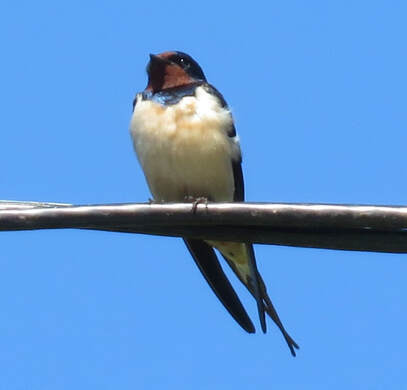
Swallows perch on a wire by Park End Farm, the sun discovering a sheen of blue on the throat and a warm flush on the breast. Light shines directly onto the swallows, bringing out colours of their fresh breeding plumage in all its loveliness.
|
|
 Early purple orchids and cowslips appear in the grass. Wych elm is thick with flowers, showing against a bright blue sky on a morning calm and still. We note the tree, thinking to return in July and look high in its crown for the white-letter hairstreak. The wych elm overhangs a sheltered woodland fringe where we found silver washed fritillary last summer. Swallows perch on a wire by Park End Farm, the sun discovering a sheen of blue on the throat and a warm flush on the breast. Light shines directly onto the swallows, bringing out colours of their fresh breeding plumage in all its loveliness.
0 Comments
 Eider duck, South Walney, 13 April 2015 Eider duck, South Walney, 13 April 2015 Wear something bright, I'd requested. I wanted a cover-shot for my new book with my friend looking out toward Piel Castle. She wore a cherry-red fleece but it was so cold she kept her jacket to hand. The wind did not drown-out the cooing of eider duck returned to South Walney in their best breeding plumage. Male eider are pistachio green on the nape, a flush of pink on the breast, and black and white plumage spectacular in sunlit flight. 21st April 2022 Eider are returned to South Walney. How will weather, tide and season come together?  Toothwort, Lathraeea squamaria Toothwort, Lathraeea squamaria A year ago to the day, we discovered toothwort deep amongst the mosses cushioning the ground in Warriner's Wood. So we hope to find flowers of toothwort today. Walking the ridge of Scout Scar I hear redpoll and see them in flight. I'm almost certain I'm hearing redstart too. It's a warm and hazy day with humidity bringing forth slugs where drops of dew are poised on blades of grass. As the morning grows warmer we might come upon a basking adder, as I did last year in mid-April.  Avocet incubating eggs Avocet incubating eggs A peaceful scene with avocet elegant and serene on their nests. So it might seem. Open the windows of the Allen Hide and the raucous screeching of black-headed gulls hits in a wave of sound. The closest avocet pair is constantly tending the nest, tidying fragments of vegetation with long, upturned bills. I reckon they're turning their eggs before fluffing up their plumage to sit and incubate. When they both stand I glimpse four mottled eggs in the nest and the waders place their long silver-blue legs and webbed feet with care. An electric fence protects the site from foxes. But that nest looks dangerously close to the water's edge, if water-levels should rise.  Male catkins of hornbeam. Carpinus betulus Male catkins of hornbeam. Carpinus betulus 'What are catkins?' he asked. The best questions are often the seemingly simple ones. Each spring, I answer with studies of tree flowers; hazel, willow, larch, bog myrtle, hornbeam and birch. They're all about us, if only we look. Finding them close to home is an opportunity to follow them through the seasons. Male catkins are usually the more striking. But the female flowers will bear fruit; hazel nuts, alder and larch cones. And samaras, the small nuts of hornbeam which hawfinch love.  Willow by the lake at Sizergh Willow by the lake at Sizergh Frost sparkles on the ground where petals of cherry blossom lie fallen. From Helsington Church, we see snow cresting the distant fells. A morning of bright sunlight and tree- flowers: blackthorn, cherry blossom, willow and maple. Bees throng about the hives in the orchard of heritage apple trees. Veils of hail shimmer through sunlight and white pellets lie on the ground with the white petals of tree- flowers. |
Archives
July 2024
Categories
All
|
|
Jan Wiltshire - Cumbria Naturally
© Jan Wiltshire 2022 All rights reserved Website by Treble3
|